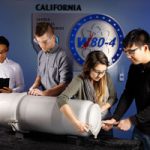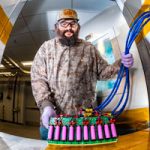Mirage software automates design of optical metamaterials
Sandia software developers have created the first inverse-design software for optical metamaterials. The new software lets users design science-fiction-like materials with the same efficiency that architects use when they draft building plans.
Device in Z machine measures power for nuclear fusion
To better determine energy leaks at Sandia’s powerful Z machine — where remarkable gains in fusion outputs have occurred over the last two and a half decades, including a tripling of output in 2018 — a joint team from Sandia and Lawrence Livermore national laboratories has installed an upgraded laser diagnostic system.
New lab offers mobile testing for devices that turn ocean waves into electricity
A new Labs facility — the Sandia Wave Energy Power Take-Off (SWEPT) Lab — offers mobile, specialized testing for systems that produce power from wave energy. Marine and hydrokinetic technologies convert the energy of waves, tides and river and ocean currents into electricity, creating the potential to provide millions with locally sourced, renewable and reliable energy.
W80-4 Life Extension Program achieves major milestone
The W80-4 Life Extension Program achieved a major milestone last month when the joint DOE and Department of Defense Nuclear Weapons Council approved the program to enter Phase 6.3, development engineering. The approval follows multiple briefings by the W80-4 leadership team to program stakeholders at NNSA headquarters and the Pentagon.
Process modernization
Modernizing the nuclear deterrent also means modernizing the weapon development process. To this end, Sandia and the Kansas City National Security Campus have established the New Product Introduction initiative. By integrating lessons learned from past weapons programs and industry best practices into the existing process, NPI can help enhance the security, reliability and performance of the nation’s nuclear deterrent.
‘MANOS’ needs a hand
Many of us can thank a teacher or mentor who early in our lives ignited in us a passion for our current professions. Sandia’s Manos — or “hands-on” — program is looking for the next generation of Sandia volunteer mentors to provide that spark for science, technology, engineering and math in local middle school students.
Sandia spiking tool improves artificially intelligent devices
Whetstone, a software tool that sharpens the output of artificial neurons, has enabled neural computer networks to process information up to a hundred times more efficiently than the current industry standard. The software, created by Sandia neuroscientists, greatly reduces the amount of circuitry needed to perform autonomous tasks and is expected to increase the penetration of artificial intelligence into numerous markets.
Robotics system demilitarizes 700,000 Army submunitions
More than 700,000 Multiple Launch Rocket System submunitions have been demilitarized since the Army started using an automated, nine-robot system conceptualized, built and programmed by Sandia engineers.
Extreme fast-charging batteries
A key roadblock to widespread use of long-range electric vehicles — the longer time needed for a complete recharge compared to a gas station fill-up — may soon be overcome, thanks to DOE support for extreme fast-charging battery research. Fueled by a $1.5 million award from DOE’s Vehicle Technology Office, Sandia and the University of Michigan have teamed up to develop engineered battery materials that can be charged in less than 10 minutes.
Power to spare: New Battery Test Facility boosts work of power sources team, with big benefits for customers
When Sandia tests the performance of high-capacity energy storage devices, the power sources group frequently would hit obstacles that reduced efficiencies and stretched out schedules. Those obstacles have now been removed with the construction of a 7,500 square-foot Battery Test Facility that enables the team to assemble and test batteries more efficiently for customers to validate whether they perform up to expectations.









